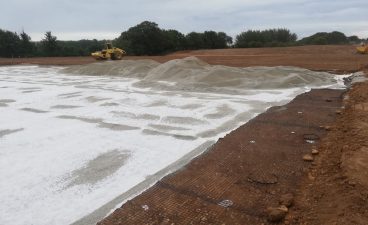Services
Project summary
- Design and build
- Sports construction
- Technical consulting
- Sustainable water management
- Environment & social
Located in the picturesque South-West of England, Budleigh Salterton is home to the tranquil Lower Otter Valley. In 2021, an Environment Agency funded project to reconnect the River Otter, estuary and floodplain meant that Budleigh Salterton Cricket Club had to be relocated to neighbouring land.
The Lower Otter Restoration Projection was set up to deliver a more sustainable landscape, rich in wildlife, whilst also ensuring that the community infrastructure was resilient to the effects of climate change and flooding.
Appointed by Kier Construction, STRI worked alongside Group companies, the Environmental Protection Group (EPG) and Carrick Construction to deliver a full design and build solution. This included the design of the cricket pitches, outfield and pitch drainage, a maintenance plan, the design of a surface water management system for the entire project (including the proposed pavilion and car park) and construction monitoring.




the
challenge
Comprehensive level adjustment works were required to achieve the necessary platforms for the cricket pitches and outfields, meaning additional work needed to be included in a tight 16-week construction programme, prior to the 12-month establishment and maintenance phase.
the
solution
Following mobilisation, the majority of construction took place during the summer months. The first phase of work included an initial site clearance, which incorporated non-residual herbicides being applied to the working area prior to the surface vegetation and topsoil being cultivated to the maximum achievable depth to enable topsoil stripping.
The level adjustment works took place prior to construction, with topsoil stripped and transported to on-site storage for reuse later in the process. Following this, a cut and fill earthworks operation was carried out to achieve the proposed gradients and formation surfaces. The screened site topsoil was then re-spread across outfield areas from the on-site storage facility.
The cricket squares were then constructed by placing a geogrid across the formation surface before a 100mm deep drainage layer was spread, levelled and compacted across both cricket squares. Both squares are being served by a basic hose point irrigation system designed and installed by STRI. The irrigation system includes above ground tanks installed on a concrete plinth with integrated pump; with the system being designed to allow for future rainwater harvesting from the building and carpark.
The drainage methodology was determined by STRI during the design phase to meet a series of planning conditions, with lateral drainage trenches and cricket square perimeter drainage trenches that connect into a network of main drains. The site-wide drainage scheme discharges to a nearby watercourse via a pre-cast concrete headwall. An attenuation pond, geocellular attenuation and flow control devices were built into STRI’s design to ensure peak discharge does not exceed greenfield runoff rates.
Following completion of the drainage works, final cultivation and seeding works were carried out on the outfield areas.
Sustainability
Working alongside Group company EPG, a full water management plan was delivered incorporating site-wide SuDS designs. SuDS help to manage surface water run-off, with EPG’s design set to manage the 100-year storm event with 40% peak flows and meeting the requirements of the Council, the Local Planning Authority and the cricket club’s flood risk assessment.
We implemented a full treatment train approach with source control as a foundational pillar. The drainage design enabled the achievement of source control treatment for run-off from contaminated surfaces which helped to minimise construction depths, reduce pipe sizes and minimise construction risks.
To protect the club and its infrastructure from flooding, and to facilitate water re-use, this project utilised several SuDs features including;
- pervious pavements for the carparks and clubhouse, which flow into permavoid units before being conveyed to an attenuation basin.
- shallow attenuation basin to attenuate and treat potentially contaminated run-off
In addition to flood management, the SuDS design protected the River Otter by reducing the volume of water flowing into it and ensuring that it had been treated prior to discharge.
the
results
- Successful delivery of the surface following 16-week construction and 12-month establishment and maintenance phase
- A playing surface has been established that is significantly less likely to flood, meaning less cancellations, more safety and a higher likelihood that it will be playable year-round
- Site-wide SuDS design provided not only flood protection but also contributed to the wider project’s aims to reconnect the river with its floodplain, creating new wetland habitats for wildlife and improving the overall health of the estuary
- Delivery within budget and timescale
let’s start our conversation today
If you’ve got a question, or would like us to help you with a project, we’d love to hear from you. Complete the form, give us a call or come and see us.





